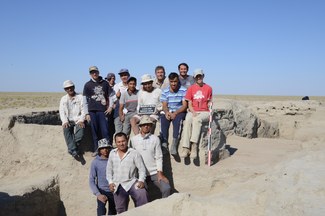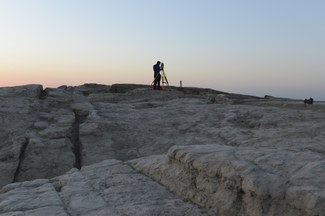Fieldwork Focus: Professor Sören Stark at the Site of Bashtepa
 During the summer of 2018 we continued our excavations at the site of Bashtepa in present-day Uzbekistan, together with colleagues and students from the U.S., Uzbekistan, China, and Italy. The ruins of our site are now situated deep in the Kyzyl-kum desert, but when it flourished – between the 3rd century BCE and the 1st century CE – it was surrounded by irrigated lands, gardens and possibly also riverine forests (called “tugai”), forming the limits of the river oasis of Bukhara in the delta of the Zerafshan river.
During the summer of 2018 we continued our excavations at the site of Bashtepa in present-day Uzbekistan, together with colleagues and students from the U.S., Uzbekistan, China, and Italy. The ruins of our site are now situated deep in the Kyzyl-kum desert, but when it flourished – between the 3rd century BCE and the 1st century CE – it was surrounded by irrigated lands, gardens and possibly also riverine forests (called “tugai”), forming the limits of the river oasis of Bukhara in the delta of the Zerafshan river.
The site was possibly founded in the first half of the 3rd century as a Seleucid border fortress, guarding one of the main routes from Sogdiana to Chorasmia. By the turn of our era it had developed into a small agro-pastoral settlement, consisting mostly of pit houses. This settlement was finally abandoned towards the end of the first century CE, together with most of the neighboring small sites (which mostly seem to represent individual farmsteads or manor houses).
 Our 2018 season evolved in three main directions: Firstly, we continued excavating the pit house horizon (1st century BCE-1st cent. CE) in the center of the site. Secondly, we excavated a deep stratigraphic trench, also in the center of the site, in order to better understand the earlier strata of the site, associated with the original fortress. Notably, we encountered (at a level of ca. 3 m above zero, that is ca. 4.5 m below the present day surface of the site in this area) a substantial burning horizon, after which the level of the fortress was substantially raised with debris and waste deposits. And thirdly, we started to excavate a series of rooms and small courtyards in the southwest corner of the site, outside and postdating the fortifications. One of these rooms was, judging from numerous imprints of storage vessels on the floor, used for storage.
Our 2018 season evolved in three main directions: Firstly, we continued excavating the pit house horizon (1st century BCE-1st cent. CE) in the center of the site. Secondly, we excavated a deep stratigraphic trench, also in the center of the site, in order to better understand the earlier strata of the site, associated with the original fortress. Notably, we encountered (at a level of ca. 3 m above zero, that is ca. 4.5 m below the present day surface of the site in this area) a substantial burning horizon, after which the level of the fortress was substantially raised with debris and waste deposits. And thirdly, we started to excavate a series of rooms and small courtyards in the southwest corner of the site, outside and postdating the fortifications. One of these rooms was, judging from numerous imprints of storage vessels on the floor, used for storage.
Our excavations at Bashtepa continue to be extremely rich in finds. We collected and registered close to half a metric ton of ceramics and ca. 150 pounds of animal bones. The latter include a wide spectrum of wild and domesticated species, including numerous fish bones, indicating the erstwhile abundance of water in the area in form of terminal river arms and marshy ponds. Among the ceramics a handful of fragments of mold-made relief bowls (so-called “Megarian bowls”) stand out, in all likelihood indicating close contacts with the Greeks in Bactria during the 2nd cent. BCE. Of particular interest among our special finds from this season are three head fragments of terracotta figurines from stratified contexts. They show close parallels with terracotta figurines from the neighboring region of Chorasmia.